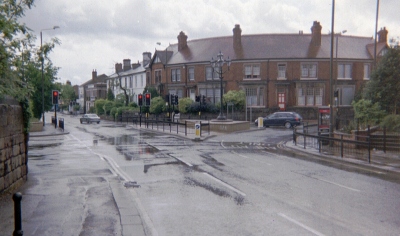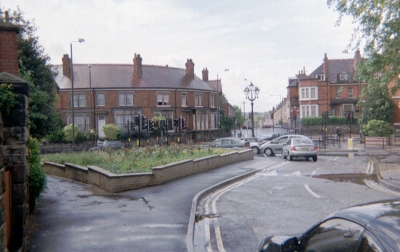
The Five Lamps fiasco in Derby and a junction off the M5 motorway - further examples of where installation of traffic signals has made road conditions worse. Initial comments relate to the Derby junction.
"There was
congestion at the rush hours, as you would expect,
but for about 22 hours of the day, you could drive freely. Not any more".
"I have received hundreds of complaints" - local councillor.
The Five Lamps
junction is located in an historic residential area of Derby.
It takes its name from an old lamp standard from which hang five globes
(seen more clearly against the sky in the second picture).

View looking south down Duffield Road with Belper Road on the left

The old 'Five lamps'
are silhouetted against the sky.
About ten sets of traffic signals can also be seen in this view taken from Belper Rd.
The junction is a complex meeting place of five or six roads (depending on how many you consider feed directly into the main junction) and leaving the traffic to 'sort itself out' rather than imposing complex signal control may have been the preferred option.
In December 2002 traffic lights were installed at
the Five Lamps junction. There followed three months of protests by both drivers and
residents - summarised in an article in the Derby Evening Telegraph of 15 March 2003.
Extracts are reproduced below.
NEW PLANS TO STEM FIVE LAMPS MISERY
Transport officials hope to end three months of misery for motorists by carrying out
alterations to the controversial Five Lamps traffic lights scheme. Derby City Council's
traffic engineers have recommended that £10,000 of improvements should be made to the
junction.
These include a £3,000 "MOVA" (microprocessor optimised vehicle actuation)
system, which uses sensors in the road to detect how long traffic queues are and to alter
the timing of traffic lights accordingly.
The proposals follow widespread public criticism of the council by motorists who claim the
£315,000 project has increased congestion since the lights were switched on in December.
It is the latest example of the council spending cash to rectify so-called road
improvement schemes. It is already spending £76,000 on tearing up unpopular speed humps
in Sinfin and Boulton.
The council's head of traffic, David Gartside, said: "This is fine-tuning, really. We
think the MOVA system will help traffic run more smoothly."
But Alan Whitelaw (50), who lives in Duffield Road, said traffic queues now lined up
outside his house all day long since the lights were introduced.
He said: "I think it needs to go back to the way it was before.
"You see money being spent on a scheme which clearly doesn't work, then you're told
that the council tax is going up - it does make people very angry.
"These proposed alterations won't make the situation any better at all."
The proposals follow a motion put forward by Allestree councillor Philip Hickson and
passed at last month's council meeting.
Mr Hickson said: "The Five Lamps lights have been the issue of the year for people in
my ward. I have received hundreds of complaints.
"These measures will do nothing to alleviate the traffic chaos the lights have caused
for people coming in and out of the city."
Abridged letter from the Derby Evening Telegraph, 15
January 2003.
"Just about everyone I know
predicted the chaos that has resulted from the traffic lights at the Five Lamps junction.
When the traffic lights are in operation there is always a period when all lights are red,
stopping traffic movement altogether. Do town planners ever model their crazy ideas?
Recent modifications to Derby's traffic systems have made the various problems even worse.
We have had a change in the city centre, which has created chaos on the inner ring road.
Additional traffic lights on the Pentagon roundabout have created tailbacks to the Wyvern
centre at times when previously there had been none. I am amazed at the practice of
stopping traffic whilst on a roundabout when access to the roundabout is already
controlled. Surely, the priority should be to get the traffic off the roundabout - not
create gridlock? Gridlock was the result on the Cockpit fiasco a couple of years ago for
this very reason.
The changes at Five Lamps have not solved problems; they have just moved them
elsewhere.......Highway planners are now doing a further study of the Five Lamps traffic,
but they are not expected to recommend switching off the lights. Well, they wouldn't,
would they? Someone should be held accountable for these fiascos that result in a waste of
taxpayers' money.
The following letter from the author of this website was published in the Derby Evening Telegraph on 28 May 2003. It produced responses from both car drivers and residents.
I was interested to see that your
recent report on road humps included an estimate of £500,000 for installation and
removal. I have published a website devoted in part to examples of local government
incompetence, including from my own village in Devon. The data from Derby are especially
useful because the large number of humps allows an accurate estimate of unit cost.
Photographs of Derby's humps will be included when the website is updated in June. It took
only a few minutes standing at the end of Holbrook Road to record vehicles being driven
down the middle of the road in both directions over the narrower of the three humps. As
shown on the website, similar problems occur in Cirencester but for slightly different
reasons. Has anyone locally had a 'near-miss' when confronted by a vehicle that had, in
effect, been encouraged not to keep to its own side of the road? It would be useful if
your readers could send me any stories about their humps - good or bad.
Also, I am interested in obtaining views of residents who live close to the Five Lamps
traffic signals. Some drivers may find them an advantage in peak times but for the rest of
the day they would seem to cause delays for motorists as well as increased noise and
pollution in the neighbourhood.
The website is www.seered.co.uk. The webpages dealing with road humps and traffic signals
are in the "government incompetence" section.
Any letters or emails would be appreciated.
Dr S J Wozniak
One of several responses from
drivers and residents in Derby.
I was interested to see your letter in today's
Derby Evening Telegraph.
Although I don't live in Derby City (for which much thanks) I am a regular off-peak user
of the Five Lamps road, by car as I live in the country. There was congestion at that
spot, at the rush hours, as you would expect as it is the main road into Derby from the
West of the city, and much of the rural hinterland. But for about 22 hours of the day, you
could drive freely. Not any more.
Now you queue at any hour of the day or night, pumping fumes into the air, while looking
at an empty road ahead because there is no traffic from the other directions. Derby
must be the only city to have created a traffic jam to leave the city at 2.30 in the
afternoon! What a waste of money!
One sensible person enquired why the council had not experimented with temporary bollards
before they spent huge sums of money narrowing - but not blocking - the rat run through
Belper Road and temporary traffic lights before they installed 3 sets, whilst still
leaving in operation 3 pelican crossings, the timings of which are not synchronised and
are a few yards away from the green men signal on all the new lights. Presumably these
were originally installed for the Children's Hospital (long since moved out of town) and
sheltered accommodation (long since university residences) but neither change has reached
the council yet, presumably.
I can only think that, if Derby has a Chief Traffic Engineer, which is debatable, he must
live on the other side of the city. And whose money is all this? I think people don't
realise that the Council's money is THEIR money!
Good luck with the campaign.
Sue
A more extensive summary appeared on the 'Derby Gripes' website http://www.derbygripe.freeuk.com. (Click on 'previous articles' then on 'five lamps'). Derby City Council was further criticised at the time on another local website.
An article in the Sunday Telegraph of 8 June 2003 highlighted recent scientific research work that could be relevant to traffic flow problems.
On the M5 motorway, junction 14 leads to the B4509 and the picturesque little town of Wotton under Edge.
Briefly, the junction operated without problems until multiple sets of traffic signals were installed. Most of the time it is a lightly used junction from the motorway, in either direction. When the traffic signals were installed queues built up at peak times and these extended down onto the motorway slip roads, potentially becoming a danger. The Police were concerned - so the lights were switched off at peak times, allowing traffic to flow freely once more. At non-peak times when the traffic signals are not needed, they are switched back on to save face for the local council who cannot bring themselves to admit that their scheme was and remains a monumental waste of money.